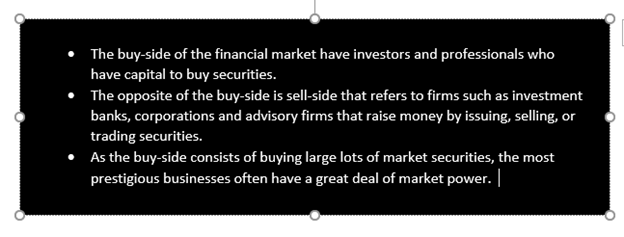What is the Buy-Side?
Buy-side is a term used in investment firms that purchase securities. These firms include pension funds, investment managers, mutual funds, insurance firms and hedge funds that purchase securities for investors or for their own portfolio with the goal of generating a return.
The buy-side of the financial market have investors and professionals who have capital to buy securities such as common shares, bonds, preference shares, derivatives or other securities issued by the sell side.
The opposite of the buy-side is sell-side that refers to firms such as investment banks, corporations and advisory firms that raise money by issuing, selling, or trading securities. It assists the market with activities related to the sale of securities to the buy-side, such a clearing services, underwriting for Initial Public Offering (IPO) and generating research material and analysis. Together, buy and sell side make up the main activities of the financial markets.

Understanding the Buy-side
Based on the needs and strategy of the company or portfolio, activities involve in buy-side includes bonds, purchase stocks and other financial products and it take place in any settings with objective to create value for the firm’s clients by identifying and investing in undervalued assets and securities that is expected to appreciate over time.
As the buy-side consists of buying large lots of market securities, the most prestigious businesses often have a great deal of market power. Although, these investments are typically not disclosed in real-time and may be somewhat ghost-like for market traders. Under the Securities and Exchange Commission’s (SEC) 13F filing needs public disclosure by buy-side managers for all the holdings purchased and sold every quarter.
Role of the Buy-side and sell-side
Buy-side
- Makes investment decisions to buy, hold or sell a security
- Manages clients money
- Aims to generate the best risk-adjusted return on capital
- Perform financial modeling and valuation
- Perform in-house research on investment opportunities
- Grow assets under management (AUM)
- Find investors and recruit capital to manage
Sell-Side
- Market and sells securities
- Advise corporate clients on major transactions
- Raise capital, including equity and debt
- Create liquidity for listed securities
- Advise on mergers and acquisitions
- Maintain relationships with corporate
- Support clients to get in and out of positions
- Perform financial modeling and valuation
- Offers equity research coverage of listed companies
Benefits of the Buy-side
Buy-side investors have many benefits over other investors, as they can buy large-lot transactions that minimize trading costs. They also have access to a broad array of internal trading resources that support them in identifying, analyzing and to act on investment opportunities in real-time.
While buy-side investors need to disclose their holding under 13F filing, which is only available quarterly. It can be beneficial for the buy-side analysts and firms to keep their watch lists and investment research proprietary.
High competition and nature of business in buy-side typically results in privacy around all trading ideas for the most optimal trading advantages.
Following Buy-side Investing
In some of the markets leading investments and investors, the quarterly 13F filing is a recommended source for all types of investors. Warren Buffett and his company, Berkshire Hathaway is the example of how buy-side investors may guide investment approaches.
Many investors will also seeks for the large investors holdings and change in them as a consideration for making a transaction themselves that is available through several online resources.
Why does Buy side Matter?
The Buy-side analyst conducts analysis for internal use only to help their firm to beat the market. It works from backend and the result of its analysis is kept private. While the sell-side conducts research for individual investors so they can make better investing decisions. However, it is highly unethical for a sell side analyst to provide suggestions on any security or assets that the analyst have interest in.
The Chinese wall separates the buy and sell-side analysts, which generally entails procedures and security policies that prevent interactions between the two units. But, this wall is often permeable than it should be. Many investment banks also provide sell-side analysis while managing proprietary trading desks where that trade their own capital for return. The buy-side investor will usually ask the sell-side analyst to issue a report to buy the stock if they want to exit a position in a favorable price.
 Please wait processing your request...
Please wait processing your request...